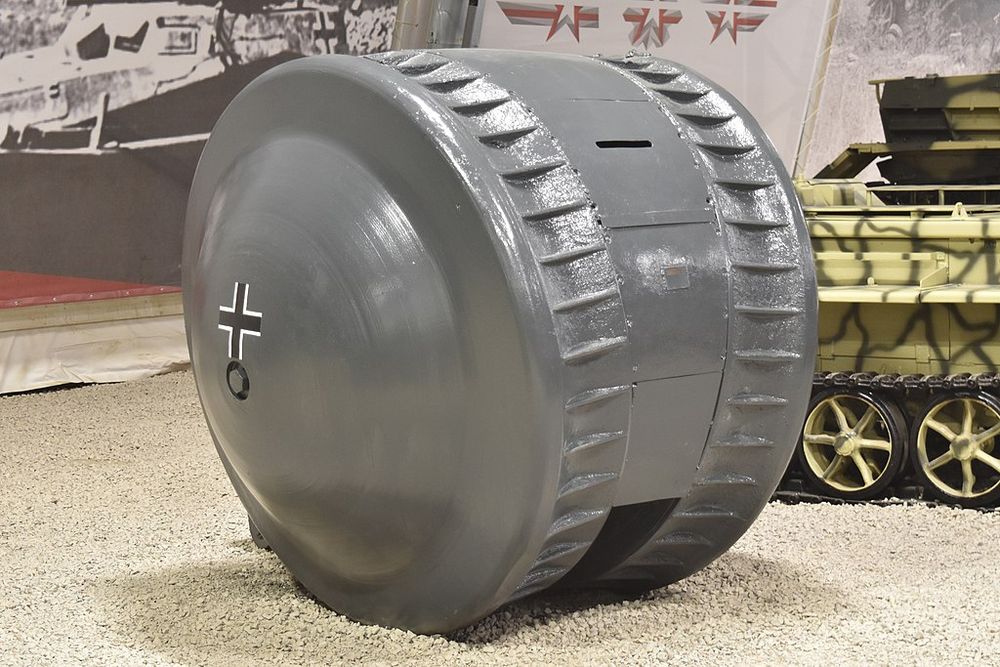When the Soviet Union invaded Manchuria in 1945 after the atomic bombing of Hiroshima, the Red Army recovered a strange vehicle from the possession of the Japanese. It was a small armored vehicle in the shape of a circular drum with only enough room to hold a single person. Currently at the Kubinka Tank Museum in Kubinka, Moscow Oblast, the curious vehicle is referred to as the Kugelpanzer, and is the only known example of a ball tank.

Photo: Morpheios Melas/Wikimedia
It’s believed that that Kugelpanzer was manufactured by the Nazis in Germany and some time later, was delivered to Japan as part of Germany’s technology sharing scheme. The Japanese army took it to Manchuria during its invasion and was subsequently captured by the Russians. Because of the complete lack of documentation on Kugelpanzer, one can only imagine for what purpose this strange vehicle was used.
The Kugelpanzer is 1.5 meters tall and moved on massive rollers the same diameter as the vehicle’s height. It was manned by a single crew sitting on a motorcycle-style saddle on the inside. A small horizontal slit in the front of the vehicle afforded the driver with only a narrow field of vision, and a slot underneath the viewport could have been used to fire a single machine gun through. The armor on the vehicle is only 5 millimeters thick, which could provide protection only against small arms fire. Even its engine was weak—a single cylinder two-stroke engine that could power the vehicle to a meagre 5 miles an hour. There is a smaller wheel on the rear of the tank for steering and keeping the vehicle upright and stable.

Photo: Alan Wilson/Wikimedia
The Kugelpanzer’s construction makes it a useless offensive vehicle on the battlefields of World War II, and so it probably played a reconnaissance role, such as observing enemy movements, artillery positions or even laying cables. It has been suggested that the Kugelpanzer was a suicide vehicle meant to ram into enemy troops and tanks. The Japanese did, in fact, employ a number of specialized suicide weapons such as the Kaiten manned torpedo, the Shinyo motorboat units, and of course, the kamikaze airplanes. However, it is unlikely that Kugelpanzer was invented for suicide attacks, because it was produced by the Germans and not the Japanese, and suicide attacks were not part of Germanic warrior culture.
Another theory is that the Kugelpanzer was an infantry support weapon, that could traverse the no-man’s land in a way that heavy armored vehicles could not. The vehicle’s large wheels, light weight, and low center of gravity are excellent characteristics for climbing over vertical obstacles and traversing ditches. The vehicle was probably invented before the war, probably as early as World War 1, when the ability to negotiate craters and trench-strewn battlefields was far more important than speed. But when the pace of war changed in Europe, the Germans realized the futility of the design and shipped it to the Japanese.

Photo: Alf van Beem/Wikimedia
The Kugelpanzer’s true purpose can only be speculated because there are no documents, and even if they exist, it is locked somewhere in Moscow’s military archives. The tank itself, until very recently, sat hidden behind a Tiger I. Its original olive green paint was covered in a gloss-grey, and its internal components, including the engine, were removed. Taking metallurgical samples is forbidden, so even after more than 75 years, no one knows what it is even made of.















Comments
Post a Comment